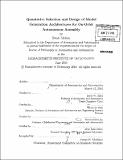| dc.contributor.advisor | David W. Miller, Olivier de Weck, Steven Dubowsky and Alvar Saenz-Otero. | en_US |
| dc.contributor.author | Mohan, Swati | en_US |
| dc.contributor.other | Massachusetts Institute of Technology. Dept. of Aeronautics and Astronautics. | en_US |
| dc.date.accessioned | 2010-10-29T18:06:01Z | |
| dc.date.available | 2010-10-29T18:06:01Z | |
| dc.date.copyright | 2010 | en_US |
| dc.date.issued | 2010 | en_US |
| dc.identifier.uri | http://hdl.handle.net/1721.1/59664 | |
| dc.description | Thesis (Ph. D.)--Massachusetts Institute of Technology, Dept. of Aeronautics and Astronautics, 2010. | en_US |
| dc.description | Cataloged from PDF version of thesis. | en_US |
| dc.description | Includes bibliographical references (p. 243-251). | en_US |
| dc.description.abstract | On-orbit assembly is an enabling technology for many space applications. However, current methods of human assisted assembly are high in cost and risk to the crew. Thus, there is a desire to automate the on-orbit assembly process using robotic technology. Automation introduces additional challenges in the design of the assembly, particularly within the control systems. During an assembly sequence, an assembler robot can undergo multiple reconfigurations of its geometry and dynamics as it attaches to and releases from individual modules. The particular problem addressed in this thesis is how to account for mass and stiffness property variations that occur with changes in configuration. Proper model generation for each configuration is critical to maintain control system stability and efficiency. This thesis explores two specific challenges associated with this problem: (1) the design of a model generation architecture to where module mass property information is known, but specific configurations are unknown; and (2) the selection of a model generation architecture that is appropriate for a given assembly architecture. Literature review of the possible model generation architectures revealed a gap in the literature, when models are aggregated online based on module mass property information. The challenge is resolved through the design of an architecture, called Online Model Calculation. Online Model Calculation uses module information obtained at the time of attachment to generate the model for the current configuration online. This is accomplished through the parameterization of the control algorithms with respect to a property vector. The property vector contains mass property information (ex. mass, inertia) that is used to generate the model. The design of Online Model Calculation, both in terms of framework and algorithm parameterization, is successfully implemented and validated on hardware. Results show a tracking error performance improvement when the correct model of the system is used in the control system over an unupdated model of the assembler along. Online Model Calculation balances a priori knowledge about the possible configurations with identification of the model online. The challenge of selecting a model generation architecture is accomplished through the development of a process that downselects feasible architectures into a single optimal architecture. This process is based on a set of generalized, quantitative metrics that are used to compare architectures from the perspectives of the control system, spacecraft, and assembly operation levels. It is exercised on three case scenarios, using a simulation tool that is developed to evaluate the model generation architecture metrics for a given assembly architecture. Results clearly show that for different assembly scenarios, different model generation architectures perform best. The quantification of this performance difference and the process for selecting the appropriate architecture constitute a key contribution of this work. | en_US |
| dc.description.statementofresponsibility | by Swati Mohan. | en_US |
| dc.format.extent | 251 p. | en_US |
| dc.language.iso | eng | en_US |
| dc.publisher | Massachusetts Institute of Technology | en_US |
| dc.rights | M.I.T. theses are protected by
copyright. They may be viewed from this source for any purpose, but
reproduction or distribution in any format is prohibited without written
permission. See provided URL for inquiries about permission. | en_US |
| dc.rights.uri | http://dspace.mit.edu/handle/1721.1/7582 | en_US |
| dc.subject | Aeronautics and Astronautics. | en_US |
| dc.title | Quantative [sic] selection and design of model generation architectures for on-orbit autonomous assembly | en_US |
| dc.title.alternative | Quantitative selection and design of model generation architectures for on-orbit autonomous assembly | en_US |
| dc.type | Thesis | en_US |
| dc.description.degree | Ph.D. | en_US |
| dc.contributor.department | Massachusetts Institute of Technology. Department of Aeronautics and Astronautics | |
| dc.identifier.oclc | 668109814 | en_US |
